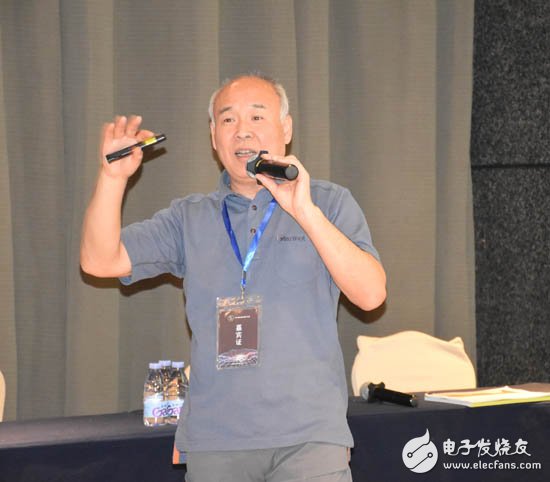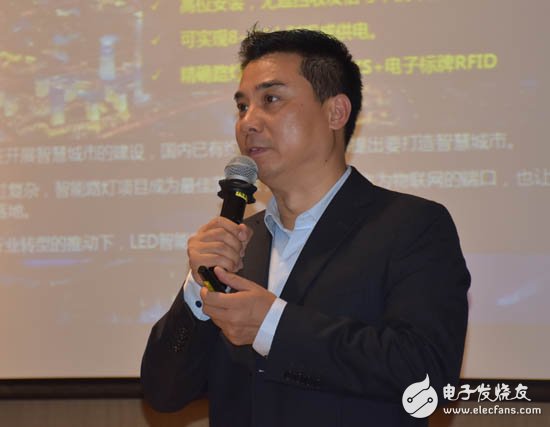In 2016, China's smart city construction has made great progress under the strong promotion of national policies, covering China's manufacturing 2025, smart healthcare, smart transportation, big data, cloud computing and other hotspots. Internet companies such as Alibaba and Tencent use industry applications and cloud computing as the starting point to promote smart city construction through an open cooperation model. ICT companies Huawei and ZTE have also entered the smart city, bringing end-to-end solutions for trial use at home and abroad. Representatives from many domestic smart cities such as Beijing, Shanghai, Guangzhou, and Nanjing also exchanged their development experiences at the forum of the High-Tech Fair.
At 2 pm on December 2, the 3rd IoT Conference Smart City Sub-forum hosted by e-seniors was held in the 3rd floor conference room on the 1st floor. Mr. Wang Lijian, Technical Director of China National Standardization Institute, Huawei IOT Platform Cloud Strategic Planning Mr. Gao Wen, Manager, Mr. Ding Luning, CTO of IGRS Information Technology Engineering Center, Mr. Huang Feng, Director of Philips Lighting, Mr. Wang Rongli, General Manager of Zhouming Technology, and Mr. Wang Haowen, Deputy Director of Application Testing Department, Key Laboratory of Sensor Network and Communication, Chinese Academy of Sciences, From the perspectives of the Internet of Things presentation technology, the development trend of the Internet of Things platform in the smart city industry, the trend of the intelligent street lamp market, and the opening of the NB-IOT test program, the latest technological progress and market trends in all aspects of smart cities are explained.
Wang Lijian, Technical Director of China National Institute of Standardization: Using OID to solve the problem of open data sharing

Wang Lijian, technical director of the China National Institute of Standardization, believes that the craze for smart cities has started in 2009. Today, the open sharing of data is the core of urban intelligence. A city will involve different environments, management environment, open environment, knowledge environment, service environment, etc., which will generate a large amount of data, open sharing and data management between data. Ability, etc., all test the "wisdom" of a city. Use OID to address the need for open data sharing.
In 2009, China began to research and promote smart cities. The Ministry of Housing and Construction and the Ministry of Science and Technology piloted 277 pilot cities in China, including 20 science and technology ministries and smart cities in the National Standards Commission. This is the highest gold content, and 20 cities are Carefully chosen. The development of standards through pilots is an important driving factor, and there are about 10 countries entering the country today.
OID is a technology for giving identification. In the International Organization for Standardization, the marking system jointly promoted by ISO/IEC and ITU covers 202 countries. Compared with Handle system and Ecode, OID logo has strong scalability and hierarchical structure. The technical system includes coding, storage and analysis. It has a wide range of applications. It is used in 202 countries in various fields such as medical and health, information security, network management and identification schemes. use. The domestic top node OID registration center, established in 2007, is responsible for managing the top OID under the Chinese node. Domestic lower-level nodes can be managed autonomously by each node organization, which is flexible and efficient.
Huawei's IoT platform strategic cooperation manager Gao Wen: Two major trends in smart cities have emerged

Population ageing, air pollution, resource shortages, energy crises, and traffic congestion are all problems that urban management faces. Managers at all levels of the city do not have a clear grasp of the actual situation and need the hardware and software of the smart city to help them. Cities of the future need efficiency, livability, innovation and sustainable development. What has Huawei done in smart cities? Gao Wen said that Huawei hopes to work with partners in the industry to become a smart city industry.
The Marketsandmarket report pointed out that the global smart city TAM is about 400 billion US dollars, including industry solutions (ICT and automatic control hardware, software) and services, and does not include infrastructure investment such as housing, pipelines and roads. The global smart city-related ICT infrastructure SAM: (Serviceable Addressable Market) is about $140 billion. This is an area that Huawei is good at.
Gao Wen said that Huawei analyzes smart cities from a technical perspective and believes that smart cities = connectivity + smart + open operating environment, the first open, operational environment provides the basis for urban innovation and sustainable business development; cloud and big data The intelligence that makes up the city; the perception and ubiquitous network connectivity.
Huawei believes that there are two major trends in smart cities: first, platform technology has become mainstream, platform technology and LPWA technology have rapidly emerged; trend 2 is that industrial ecology is from single to complex. In the past, smart parking became a system, and smart transportation became a system. Now we need to get through the various systems to form an end-to-end solution. Smart cities form three different levels of smart cities in the UK, South Korea and Singapore. The smart city of Dubai and the smart country of Singapore are in the 3.0 smart city program, featuring emerging technology-driven, front-end awareness and data collection, and intelligent integration of data.
Wang Rongli, General Manager of Chau Ming Technology: Smart Street Light is the best entrance to smart city

Mr. Wang said that the fragmentation of IoT applications is obvious. Because the smart city system is too complicated to build, the intelligent street lamp project has become the best place to drop. The urban street lamp is used as the port of the Internet of Things, and the construction of smart city can be better. . Smart street lights have three characteristics of perception, interconnection and intelligence. 70% of the street lights in Shenzhen are implemented by Chau Ming Technology, including Guangzhou-Shenzhen Expressway, Civic Center, Pingshan New District and Longgang New District.
Researching the reality, the scale of the Internet of Things will exceed 100 billion in the future, and the scale of smart street lamps will exceed 100 billion. As the country vigorously promoted the arrival of smart cities, the penetration rate of LED street lamps increased rapidly. In 2015, the penetration rate of China's LED street lamp market exceeded 25%. According to CSA Research, it is estimated that by 2020, the penetration rate will increase to 39%. In the future, with the further advancement of smart cities and the increase in the penetration rate of LED street lamps, the future development of smart street lamps is huge.
Huawei released the first multi-level intelligent control lighting Internet of Things solution this year. This solution can integrate urban lighting street lights into the IoT network and visually manage it based on GIS. Managers can clearly understand every street and every street lamp. State information; by applying a flexible lighting strategy, the switching status and illumination brightness of each street lamp can be precisely controlled to achieve on-demand illumination. ZTE also announced the "BluePillar" smart street lighting solution as an important place for its smart city strategy this year.
Zhouming Technology has four unique advantages in the field of smart street lamps: the leading LED lighting energy-saving service company in China, the national contract energy management mode service street lamp more than 600,000 miles, has a unique resource carrier; global LED display leader: Smart street light LED display video playback escort; Zhou Ming Technology in the country to achieve a mature intelligent control system case project, to achieve intelligent street lights landing and profit. Nandian cloud merchants with resource sharing: provide various interfaces and technologies in charging piles.
Rice Mill Plant Machine,White Rice Polishere,White Rice Polisher,Water Polisher
HuangShi Stee Metal Material Technology Exploitation Co.,Ltd , https://www.wosenstechnology.com